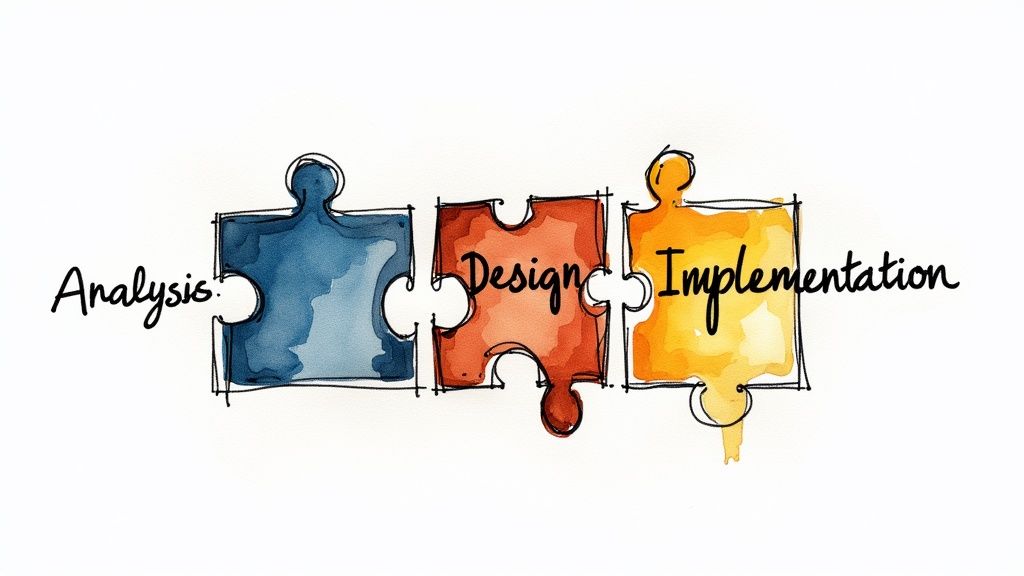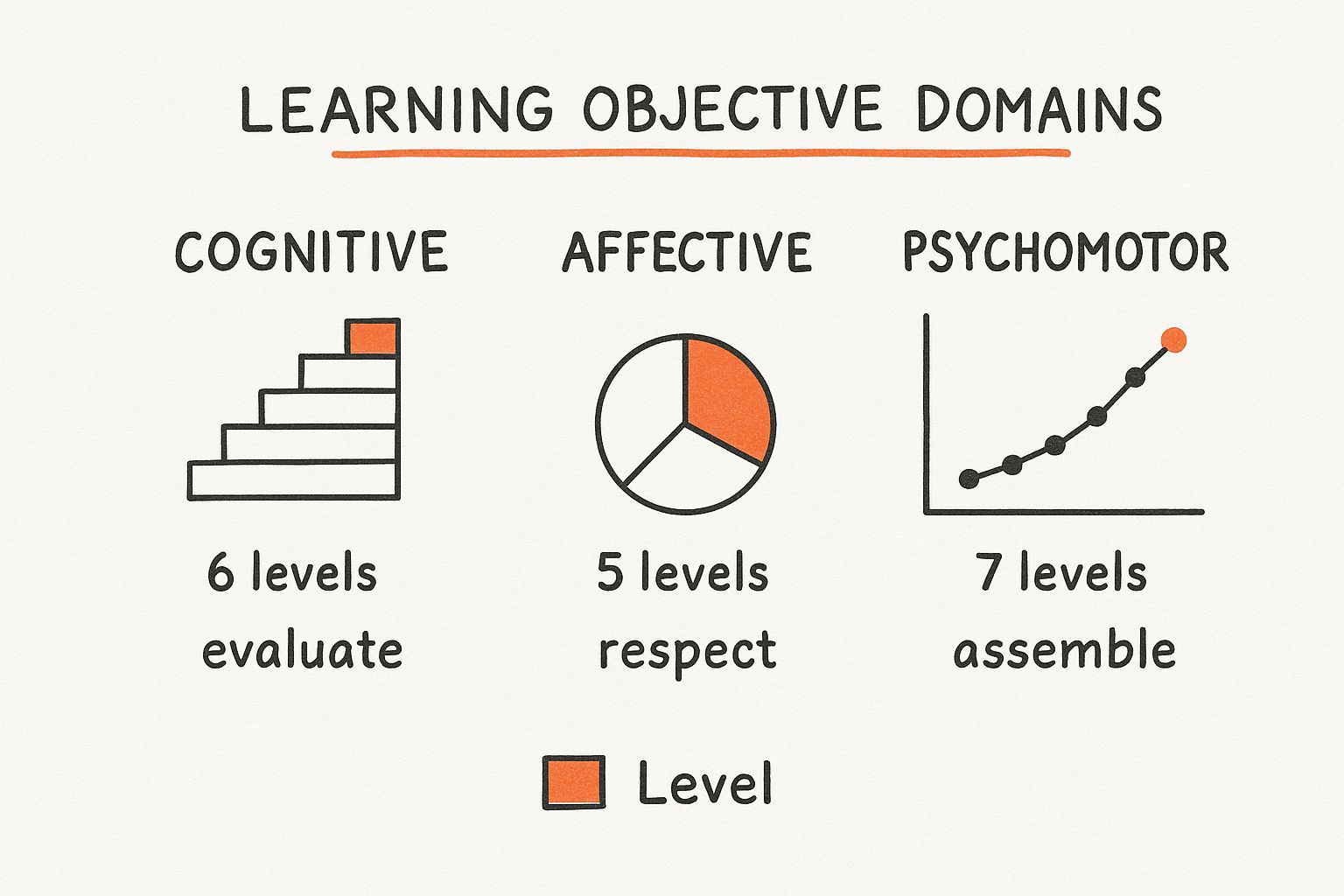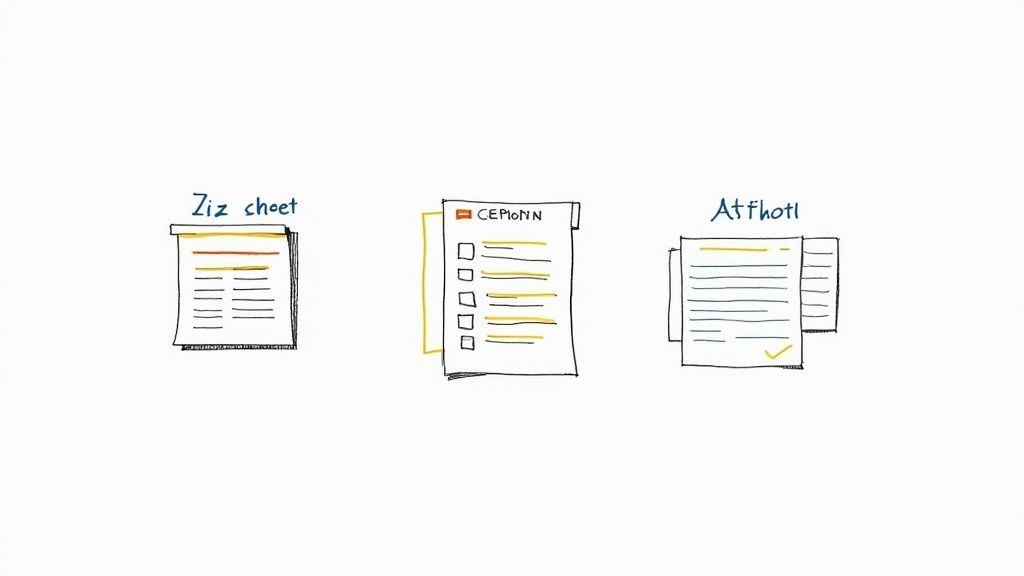
At their core, instructional design principles are the secret sauce for creating learning experiences that actually work. They're the proven guidelines that blend the science of how people learn with the art of creative design. It's about moving beyond just dumping information on people and, instead, building a structured journey that leads to real skills and knowledge that sticks.

So, you're thinking about moving into the world of corporate instructional design? Fantastic. If you’re coming from teaching, academia, or even graphic design, you’re bringing a ton of valuable skills to the table—probably more than you realize. Your background has already set you up for the main mission: building training that helps employees and the company win.
Think of your new role as being an architect, but for learning. You’re not designing buildings; you’re constructing training programs that solve real business problems. It's a fantastic mix of art and science. The "art" is where your creativity shines—crafting a compelling story and designing something that's a pleasure to use. The "science" is all about applying solid instructional design principles to make sure the training delivers results.
The good news is that the skills you already have are a perfect launchpad for this career. What you've been doing all along has a direct parallel in the corporate learning space.
The goal isn't just to make a course; it's to create change. Great corporate training improves performance, closes skill gaps, and directly helps the company hit its targets. Your job is to design learning that makes that happen.
This guide is designed to walk you through the core theories, models, and modern tools that are shaping the field right now. To see what this looks like in the real world, check out the roles available at https://relevant.training to get a feel for what companies are looking for. We’ll cover everything from the bedrock principles of learning science to hot topics like AI and Microlearning, giving you a solid roadmap for what’s ahead.
Before you even think about firing up tools like the Articulate Suite or Adobe Captivate, we need to talk about what’s happening between a learner’s ears. Understanding how the human mind actually works is the secret sauce that separates a good instructional designer from a great one.
It’s the difference between building a course that’s just a box-ticking exercise and creating a genuine learning experience that sticks.
This all boils down to a few core learning theories. Don't worry, we're not about to dive into a dry, academic textbook. Instead, think of these as different lenses for looking at a learning problem. Each one gives you a unique angle and a fresh set of tools to solve it.
Let’s start with the most straightforward theory: Behaviorism. At its core, it’s about learning through repetition and feedback. The idea is that you can shape behavior by rewarding the right actions until they become automatic.
Think about how you learned to type without looking at the keys. It was all about practice, practice, practice. You hit the right key, the letter appeared—positive reinforcement. Over time, the action became second nature. That's behaviorism in a nutshell.
In the corporate world, you'd lean on this for:
When the goal is to build a specific, observable skill through pure practice, Behaviorism is your best friend.
While Behaviorism is all about what people do, Cognitivism peeks inside the brain to see how people think. It treats the mind like a computer, focusing on how we process, store, and retrieve information.
As a designer, your job is to be a master organizer. You're not just dumping information on learners; you're helping them build a mental filing cabinet with neat, clearly labeled folders so they can find what they need later.
This is where you realize that how you structure information is just as important as the information itself. Things like clear visuals, a logical flow, and breaking down big topics into bite-sized chunks are all classic cognitive strategies.
This approach is perfect for any kind of knowledge-based training. If you need to explain a complex financial product or get the team up to speed on a new company strategy, you’ll be thinking like a cognitivist.
Now we get to Constructivism, which is all about learning by getting your hands dirty. This theory says that people learn best not by being told things, but by actively building their own understanding through experience.
It’s like the difference between reading a manual on how to build a LEGO car versus being handed a box of bricks and a challenge to create a car that actually rolls. The second way forces you to experiment, problem-solve, and figure things out on your own.
In a training context, this looks like:
This shift from simple repetition to active, hands-on learning is a huge part of modern instructional design. If you look at the history of our field, you'll see a clear move away from basic behaviorist models toward more cognitive and constructivist approaches. We’re finally focused on empowering people to build their own knowledge, and you can see how these learning theories shaped modern instructional design in everything we create today.
Once you’ve got a handle on the science behind how people learn, it's time to put that theory into practice. But where do you even start when building a training program from scratch? Instructional designers don't just wing it; they rely on proven frameworks—think of them as blueprints—to guide the entire process, from that initial request to a polished final product.
These aren't meant to be rigid, unbreakable rules. They're more like flexible toolkits that add much-needed structure to what can be a messy, creative process. If you’re coming from a background in teaching or graphic design, these models will probably feel pretty familiar. They offer a systematic way to manage a project and make sure nothing important falls through the cracks.
The most common and foundational framework you'll encounter in the corporate world is ADDIE. It’s a straightforward, five-step process that instructional designers have leaned on for decades to keep their projects organized and moving forward.
Let's say a manager taps you on the shoulder and asks you to build a training module for a new software launch. Here’s how you could use ADDIE to tackle it:
ADDIE gives you a clear, logical path that makes sure you've covered all your bases. It's the dependable, step-by-step guide that keeps projects from going completely off the rails.
If ADDIE is the framework for managing the whole project, think of Gagne’s Nine Events of Instruction as the recipe for a single lesson or module. Developed by Robert Gagné, this model breaks down the learning process into nine key moments a person needs to experience for new information to really sink in and stick.
This kind of systematic approach has surprisingly deep roots. The origins of instructional design can be traced all the way back to World War II, when specialists had to rapidly develop training materials for masses of soldiers. Later, in the 1950s and 60s, thinkers like B.F. Skinner, Benjamin Bloom, and Robert Gagné himself laid the groundwork for the principles we still use today, mixing behaviorist and cognitive psychology to create goal-focused learning. You can actually read more about the history that shaped modern ID principles and see how these big ideas came to be.
Let's go back to our software training example. Here’s what Gagne's events would look like in action:
Following this structure ensures you’re not just throwing information at people; you're guiding them through a complete cognitive journey from "I don't know" to "I've got this."
ADDIE and Gagne's are foundational, but they're just the tip of the iceberg. There are many other models out there, each with its own strengths. The table below breaks down a few of the most popular ones to help you see how they stack up.
Choosing the right model really depends on your project's goals, timeline, and your own working style. Many experienced designers even mix and match elements from different models to create a process that works best for them.
The infographic below does a great job illustrating the different domains of learning objectives, which can help you visualize the kinds of skills you might be trying to build.

As you can see, learning isn’t just one thing. It spans from thinking (Cognitive) and feeling (Affective) to doing (Psychomotor), and a great training design makes sure it’s targeting the right domain for the job.

This is where the magic happens—where your grasp of learning science meets technology. A modern instructional designer is part artist, part scientist, and part tech wizard. To bring your training vision to life, you need a solid handle on the digital tools of the trade. Think of it as your workshop, filled with everything you need to build, test, and launch incredible learning experiences.
If you're coming from a background in teaching or graphic design, some of this software might feel new, but don't worry. This is where your existing skills will really start to shine. Let's break down the essential tech so you can talk the talk in interviews and understand what's listed on job descriptions.
The real workhorses in any instructional designer's toolkit are the eLearning authoring tools. This is the software you'll use day-in and day-out to create interactive, media-rich training from the ground up. In the corporate world, two names dominate the landscape: Articulate 360 and Adobe Captivate.
Seriously, knowing at least one of these platforms is pretty much non-negotiable for most corporate jobs. They are as fundamental to us as Photoshop is to a graphic designer.
Okay, so you've built a beautiful course. Now what? It needs a home, and that's where learning platforms come in. You'll hear the acronyms LMS and LXP thrown around constantly, and it's vital to know the difference.
A Learning Management System (LMS) is the classic, old-school home for corporate training. Think of it as a digital library or administrative office. Its main job is to host, deliver, and track formal training. Companies use it to assign mandatory compliance courses and pull reports to see who’s done what. It’s all about management and control.
On the flip side, a Learning Experience Platform (LXP) is more like Netflix or Spotify for learning. Instead of just pushing out required courses, an LXP offers a massive, curated library of content—articles, videos, podcasts, you name it. It uses AI to recommend resources based on an employee's role, skills, and career goals. It’s all about discovery and empowering the learner. The LMS manages, but the LXP engages.
The tools we use are always changing, and right now, two of the biggest forces shaping our field are AI and Microlearning. These aren't just buzzwords; they're fundamentally changing how we create and deliver training.
Artificial Intelligence is quickly becoming an instructional designer's co-pilot. It can help brainstorm and draft course content, create realistic avatars for scenarios, translate courses into a dozen languages, and even personalize learning paths for thousands of employees automatically.
Microlearning is all about breaking down content into small, focused, bite-sized pieces. Forget the 60-minute module. Think more along the lines of a two-minute explainer video, a quick interactive quiz, or a handy one-page job aid. This approach respects the learner's packed schedule and is perfect for providing support right when they need it on the job.
Keeping up with these trends is key. You can find more deep dives into these topics on the https://relevant.training/blog, which is a great resource for staying on top of what's new and what's next in the industry.
Okay, so we've talked a lot about theories, models, and fancy acronyms. But where the rubber really meets the road is when a real-world business problem lands on your desk. This is your moment to shine, to connect the dots between learning theory and tangible results.
Let’s walk through a few common requests you'll almost certainly get as a corporate instructional designer. Think of these as a chance to see how all those instructional design principles come together to solve actual problems for real people.
Your sales manager flags you down. They've just rolled out a new sales process—it's brilliant, but a little complex. The problem? The sales reps are constantly on the move and don't have an hour to spare for a traditional training session. They need something fast, mobile, and right to the point.
This is a classic case for Microlearning. You're not going to build a massive, 45-minute course. Instead, you'll create a handful of focused, bite-sized assets they can pull up on their phones between client calls.
Here’s how you'd tackle it:
The result? You’ve created training that respects the sales team's time, solves their immediate needs, and helps them close more deals. That's a win.
Next up, HR needs your help. They're hiring more remote employees than ever, and they need a structured onboarding program. The goal is simple but crucial: make new hires feel welcome, get them up to speed, and help them feel ready to contribute within their first 30 days.
This is a bigger beast. It calls for a thoughtfully structured journey, probably housed within the company's main Learning Management System (LMS). Your job is to design a pathway that blends critical information with genuine human connection.
This is so much more than just sending a new hire a folder of PDFs. You're crafting an experience that builds their confidence and helps them feel like part of the team from day one.
You’d use the LMS to map out a clear, week-by-week plan that looks something like this:
This kind of structured, guided approach takes the guesswork out of starting a new job, making the whole process way less overwhelming and far more effective.
And finally, the email you knew was coming arrives. It's time to update the annual cybersecurity compliance course. Last year's version was a glorified PowerPoint that everyone clicked through as fast as humanly possible. Your mission: make it engaging. Or, at the very least, not mind-numbingly dull.
This is the perfect opportunity to flex your creative muscles with a tool like Articulate Storyline. Instead of just listing a bunch of rules, you're going to build an interactive, scenario-based experience that puts employees in the driver's seat.
Think about it:
Every choice has a consequence, and the course provides immediate, contextual feedback. This is a classic constructivist approach—people learn by doing, not by reading. You can even sprinkle in some gamification elements like points or a progress bar to turn a mandatory chore into a fun challenge. Suddenly, you've transformed a boring compliance task into something that actually sticks, boosting both engagement and retention of information that could save the company from a major headache.

Thinking about a career change is a huge deal. It’s natural to have a million questions spinning around in your head. For former teachers, professors, and even graphic designers, moving into the world of corporate instructional design is a really exciting—and logical—next step. You already have so many of the skills you need to succeed.
Let's dive into the questions we hear all the time. We’ll get you some clear, honest answers so you can move forward with confidence.
Let’s get one thing straight: your portfolio is everything when you're starting out. It’s the living proof that you don't just know the theory of instructional design principles—you can actually build something with them. Hiring managers need to see what you can do.
Forget about creating a dozen mediocre projects. For your first portfolio, quality beats quantity every single time. Aim for 2-3 solid, well-rounded projects that show off your skills.
Here's what you should focus on:
This is the big one, especially for people coming from fields like teaching that aren't traditionally tech-heavy. The honest answer? You need to be comfortable with the core tools of the trade, but you absolutely do not need to be a programmer.
Your main goal should be getting good at an industry-standard authoring tool. Right now, that’s the Articulate Suite, particularly Storyline and Rise. You should be able to build a course from a blank slate, add things like quizzes and branching scenarios, and know how to publish it for an LMS. If you have some basic graphic design skills (even just with Canva) and can do some simple video editing, you'll be way ahead of the game.
The point isn't to be an expert in every piece of software out there. The goal is to master the right software and show that you're an adaptable, curious learner who isn't afraid to get their hands dirty with technology.
Tech skills will get your foot in the door, but it's the "human" skills that will build your career. Companies aren't just looking for people to build courses. They want strategic thinkers who can help solve real business problems.
Looking at job postings right now, these are the skills that keep popping up:
Ah, the great debate. The answer isn't a simple yes or no. A master's degree can be incredibly valuable, giving you a deep foundation in adult learning theory and formal instructional design principles.
But is it a hard requirement to land a corporate job? For most roles, no. A killer portfolio packed with real-world projects will almost always beat a degree by itself. So many of the top instructional designers working today came from totally different fields and learned on the job. They built their skills, created a portfolio that wowed, and proved their value.
If you're trying to decide where to invest your time and money, building practical skills and projects might be the fastest way in. You can always explore the huge variety of careers in learning and development to see which paths feel right for you.